We have had recorded sound since 1877 when Thomas Edison invented the Tinfoil Phonograph. Sound waves were recorded and reproduced on a tin foil cylinder.

We have had the disc format since the late 1880s when Emile Berliner debuted his improved Gramophone.

Records are delicate but with proper care, they are an enduring form of media that can last centuries. Proper care and enjoyment of records should not be a mystifying concept.
In my opinion, they are the best sounding medium. This is a simple tutorial of things I have learned along the way. I’m not going to bog anyone down in audiophile explanations or get into specialized topics like Edison Diamond Discs in this overview. As time goes on I’ll make pages for specialized topics but this is intended for people who are just starting out. I am writing this for people who simply want to know how to play and care for what they have inherited or found a thrift shop.
The other reason I am writing this is because I have looked through so many bins of records people haven’t properly cared for. It’s always dismaying and I try to save what I can. I strongly believe we should know how to care of our cultural legacy.
Parts of a Turntable
Knowing the parts is usually a good first step towards an understanding of a new concept. I have inserted photos from the Audio Technica AT-LP 120 manual as they provide solid explanations of the concepts and parts comprising a turntable.
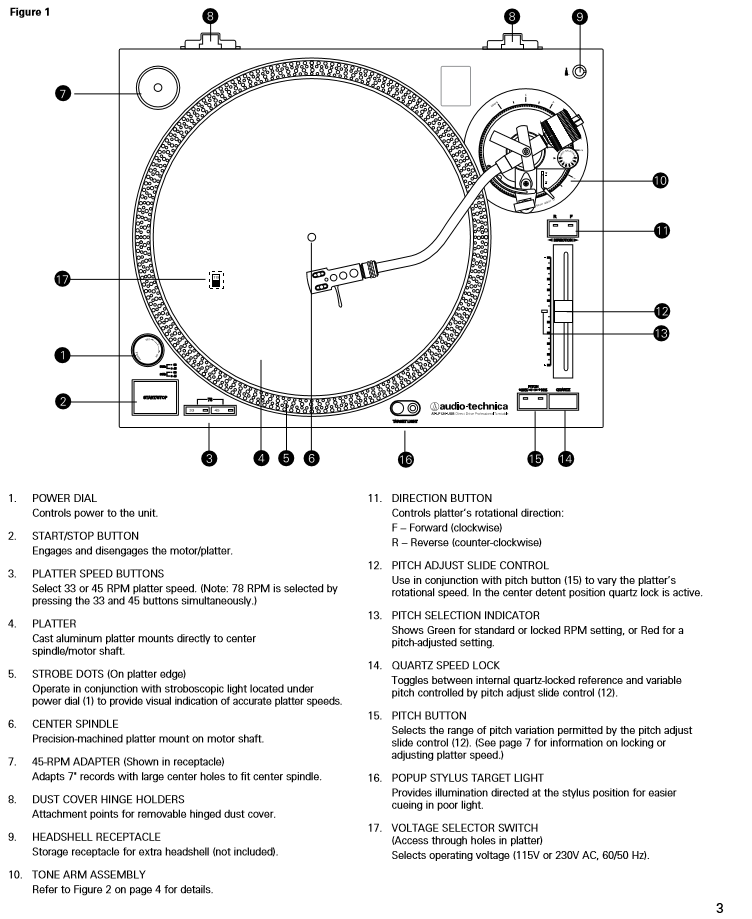
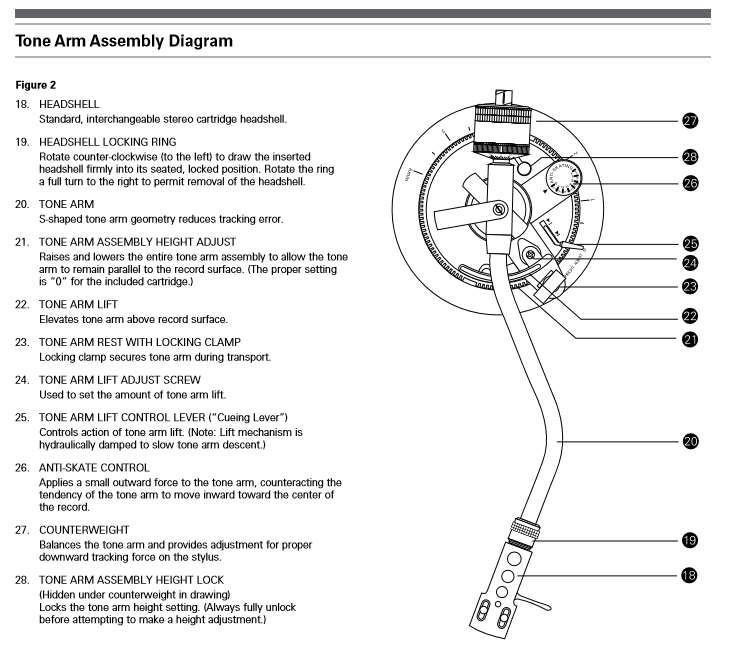
Buy a Nice Turntable
My first unit was one of those cool looking cheap retro models you can find at a popular retailer near you. Don’t go this route. I used it for a few years and got what I paid for out of it but regretted my purchase. My regret was rooted in the fact that I couldn’t control how much force was exerted onto my record (counterweight), it had a belt drive that sometimes had speed variances, and lastly it was an automatic player that would sometimes not play the last few grooves of my record.
Let me explain what this means.
Look for something with an adjustable counterweight. Stylus manufacturers have set ranges of acceptable tracking force that you should be diligent to stay within.
This set up video for the Audio-Technica AT-LP 120 on YouTube easily explains what this process entails.
There are a few reasons to be diligent about tracking force. You will maximize the lifespan of your stylus. The average diamond stylus is 800 to 1000 hours and the average sapphire stylus is about 500 hours. Exerting too much force will wear your stylus down quicker. Never play a record with a dull stylus! It will damage the record.
Most importantly the concept of tracking force revolves around proper record care. Exerting too much force in the grooves will damage and destroy your record collection! People often say that the cheap retro models “eat their records” because many of them don’t have an adjustable tracking force and often times those models have a heavier weight bearing down on records.
Now, many times people weigh out whether they should get a belt drive or a direct drive. If you have no background with this subject at all I recommend looking at the Wikipedia entries for a basic explanation and to read the pros and cons of both.
https://en.wikipedia.org/wiki/Belt-drive_turntable
https://en.wikipedia.org/wiki/Direct-drive_turntable
I have dealt with both. I don’t think I would ever buy a buy one with a belt drive again. I can attest that mine had speed variances and ran a bit louder than my direct drive model. This could be because my belt model was a cheap $100 model.
Lastly manual versus automatic. Manual means you have to place the stylus on the record and when the tonearm reaches the end you have to be the one to lift it up and place the arm back in the rest. With an automatic player you place the stylus down and once the record is done the tonearm lifts up and mechanically returns to its rest. Generally speaking, if you buy a new table at present the cheaper models are automatic and better models are manual.
Think about these things and do your homework before purchasing a new table. In your research read reviews and specifications and assess potentially how you would like to use your machine. I did this before purchasing my Audio-Technica AT-LP 120 and I can say I have the best machine for my needs. It is a reasonably priced model that has professional features. I enjoy playing all kinds of different records and it is how I get my recordings online.
I highly recommend buying a turntable with a USB connection. I think everyone should digitize, preserve, and post their findings. It is our cultural history and legacy. Digitization and preservation make it so the world of today and tomorrow can hear the world of yesterday. Not to mention you can bring the sound of your records into your car and other places that you can’t have your record player with you. Simply load those files onto a phone or mp3 player and you have all your records at your fingertips!
This is probably rather common sense but once you decide on a model carefully and thoroughly read the instructions as you assemble and set up your new player.
Preamplifiers, Amplifiers, and Speakers
You can’t just hook your turntable into a pair of speakers and hear everything.
You need to ask does my turntable contain a preamplifier? A preamplifier boosts the signal strength. If it does good. If not, you will need to purchase one.
Then comes speakers. To boost your signal even more you will need an amplifier connected, or you can buy what is known as active speakers. Those have a built-in amplifier.
But if all this is too complicated or if you are like me and live in an apartment where space is at a premium you can use your computer speakers provided you have a USB turntable. This is the simplest and cheapest way to enjoy and my records sound great!
The advice from the ION website taught me how to use my computer speakers.
Accessories
You will need some other small purchases to keep your set up going.
Buy or download a Stevenson protractor for aligning your cartridge. I recommend the vinylengine website
Basically, you have to loosen the bolts at the top of the cartridge and wiggle the cartridge back and forth until it is sitting in the center of the two boxes. It is very hard! But it is needed because aligning your cartridge makes sure that the stylus is riding through the center of the groove.
Buy a small digital scale to precisely adjust your counterweight.
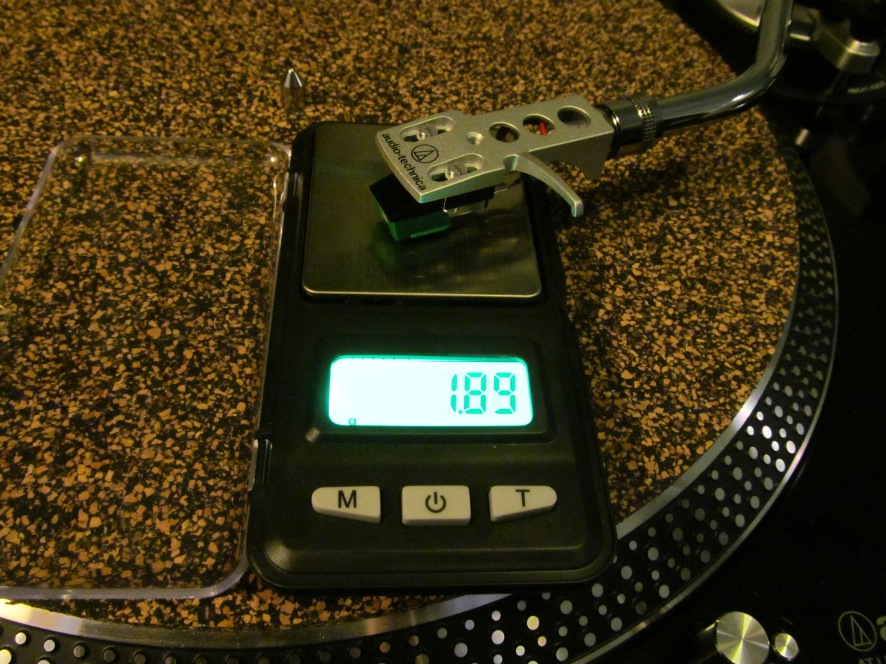
Main Cleaning
You will need supplies for record cleaning. I never put on a record without cleaning it first, even a brand-new record that has been sealed in plastic can have dust, dirt, or chemical residue from the factory.
Once again this is about keeping your records and stylus in good health. If your stylus drags across a dirty record it will wear out quicker and the dirt can impede the quality of playback.
A few months back I devised a guide for cleaning shellac 78s.
Clean and Preserve Shellac Records
I stand by this guide and use this as my main cleaning of all my records be it shellac 78 discs or vinyl discs. A spray bottle filled with distilled water to spray on the disc is a gentle and effective cleaning method. I wipe a microfiber cloth with and never against the groove pattern. In the 78 guide, I said to go clockwise. I figured most people are right handed and it would be the easiest explanation, but clockwise or counter clockwise is acceptable as long as you are feeling your motion lock with the grooves.
Since writing that guide I have encountered a few discs that have been mud coated. They were shellac records that appeared to have sat in a barn for decades. I needed something a bit stronger than water because the mud was deep in those grooves. Keeping away from the label, I used a gentle dish soap for the particular stubborn disc. I gently scrubbed it with my microfiber cloth and rinsed all soap off. After it dried I played it and it sounded fine.
Once cleaned and dried all my records are put in archival materials. Never put away a wet record it can get grow mold or mildew! I buy acid-free paper sleeves and poly sleeves. Acid-free paper is good for the health of the record and the poly sleeves keep dust and dirt out. I suggested polyethylene sleeves before but polypropylene is also good. I buy whichever one I can get a better deal on but some people develop a strong preference.
When handling the records always handle by the edges or label as to not get skin oils on the disc.
Touch Up Cleaning
I really like the AT6012 Audio-Technica kit I bought bundled with my turntable. I use it to touch up my vinyl records before use.
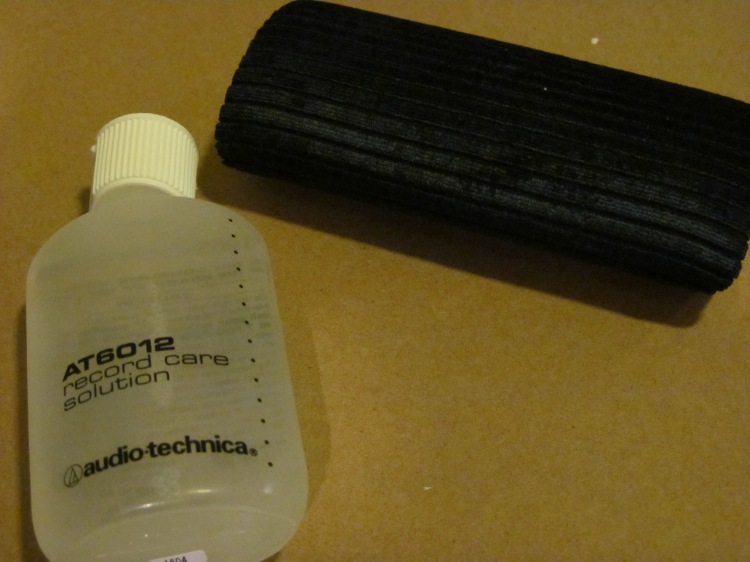
Get a carbon fiber brush and a stylus brush. Before each play, while my tone arm is locked I use my stylus brush. I brush it in a back to front motion. This will remove dust and dirt.


Before each play, while the clean disc is rotating I move my carbon fiber brush in a counterclockwise motion from the 12 o’clock position to the 6 o’clock position. From the 6 o’clock position, I push any particles downward and off the record. You might have to sweep twice before you are ready to play. This improves playback because you will hear a pop if a hair or other particles are run over by the stylus.
My optional but recommended suggestion is to buy a nice mat. I live in a climate with a pronounced winter season. Things in my house can become dry and statically charged. I use a cork mat to cut down on static and I think it makes my records sound nicer. Cork can deaden excess vibrations and open up additional frequencies.

Types of Records
At this point, you will have notice I have used the terms shellac records and microgroove records. Pay attention to those terms they are important.
I’m going to give you a general statement of what you are likely to encounter. Records made out of shellac span the first half of the 20th century. They are thick and heavy discs made out of shellac. Most of the time they will be 10” in diameter, but you may find some that are 12”.

They have wide grooves. In an 1891 speech published in Transactions of the American Institute of Electrical Engineers, Emile Berliner showed this image to demonstrate the grooves of his disc records.
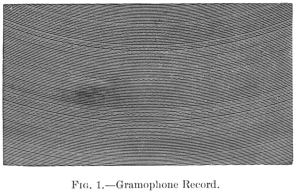
The microgroove record was released in 1948. These records are made out of polyvinyl chloride and are thinner and lighter, but most importantly these grooves are very small and narrow.

These would be your 7″ 45 rpm discs and most commonly your long playing (LP) 33 1/3 rpm 12″ discs. Some of your early microgroove long playing records are 10″ you may encounter some of these in your record buying.
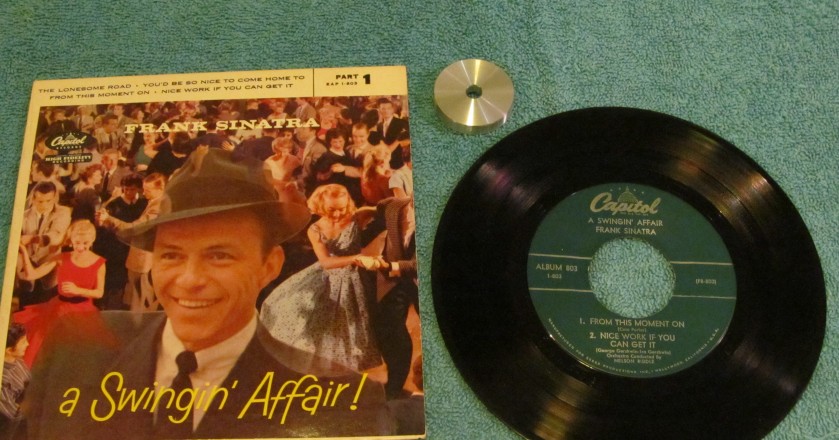
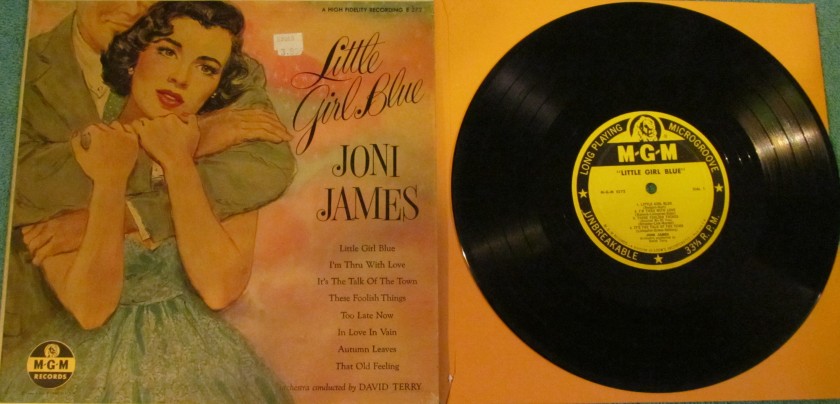


When I bought my first turntable in 2013 I bought one with three speeds (33 1/3 rpm, 45 rpm, 78 rpm). Even then I knew I wanted to get into 78 rpm discs. I’ve always loved old music and wanted a table that would give me that option. However just because your player can rotate at 78 rpm does not mean the stylus that comes with the machine is appropriate to play this style disc!
Turntables come with a stylus equipped for microgroove records. The most popular records of the last half of the 20th century were microgroove releases so it is only natural that manufacturers will assume that your records are all vinyl microgroove discs.
When I first got into 78s I played them with my microgroove stylus. Never ever do this! If you have done this don’t put another record on and replace your microgroove stylus immediately. When you do this the microgroove stylus sinks to the bottom of the wide groove. It scrapes and pulls up old dust and debris while failing to touch the walls of the groove where the sound is etched. This results in potentially damaging your record, damaging your stylus, and a playback ridden with surface noise. I simply thought that all old recordings had that much surface noise. I was wrong. Shellac 78 rpm discs have some surface noise but sound amazing when you have the right set up!
My 78 RPM Setup
78 rpm wide groove discs are a specialty area of record collecting. If you know for sure or think you may want to collect these discs factor it into your turntable purchase. When I bought my AT-LP120 I factored in my wide groove collection.
You will want a quality table that allows for you to easily remove the headshell. This is the safest way to go between styli. My AT-LP120 came with a headshell that houses the AT95E cartridge which has a microgroove stylus that I use only on my vinyl records. I bought an additional headshell and installed a Shure M78S phono cartridge/stylus. If you go the AT-LP120 route you will need to upgrade to a heavier counterweight to play 78 rpm discs or if you wish to upgrade to a high-end microgroove phono cartridge.

Record Shopping and Other Records to be Played with a Microgroove Stylus
Likely you won’t buy all your records new and you will be hunting records from second-hand stores, flea markets, and antique stores. Here is a guide I devised for someone with no experience.
Things to Look for When Buying Used Records
Here are some other specialty discs you will likely encounter in your record buying journeys.
Colored vinyl—This is pretty self-explanatory. They are special issues that come in a vivid color or colors.
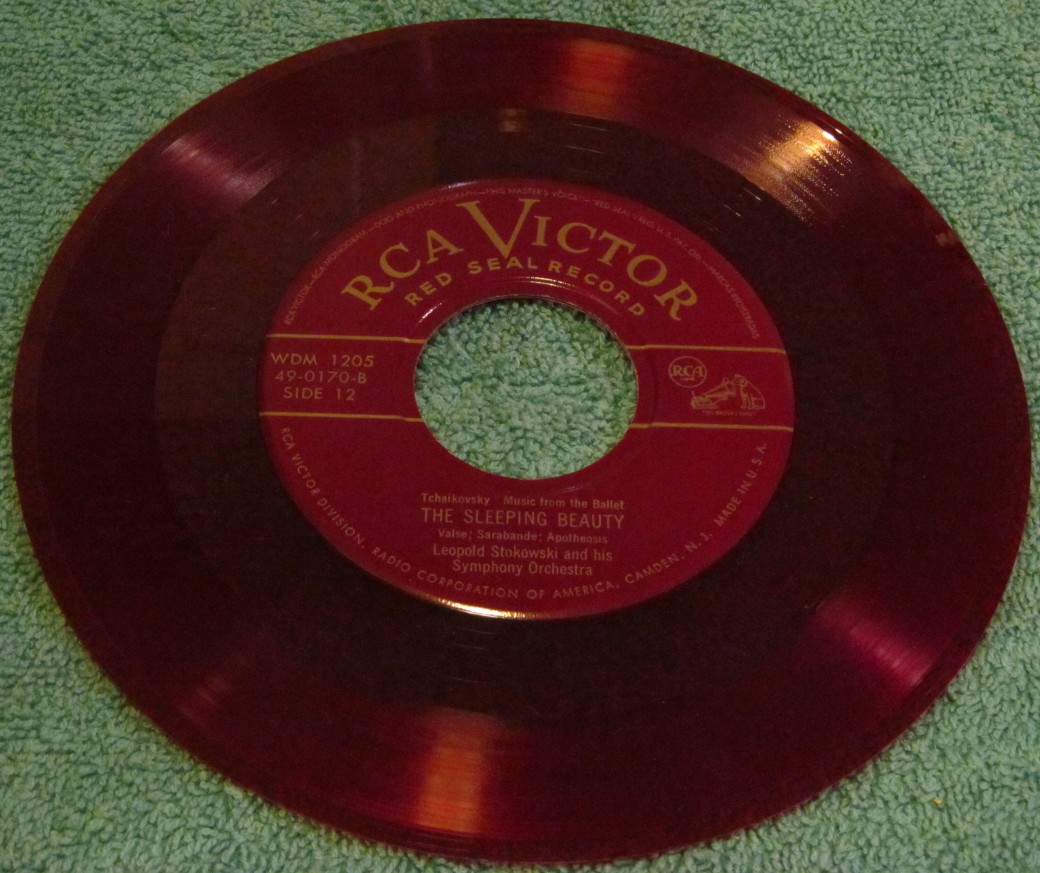
Picture discs—This is my only one. They are an interesting novelty and fun to look at but I don’t often pursue them. Picture discs tend to sound muddier and lack in sound quality.
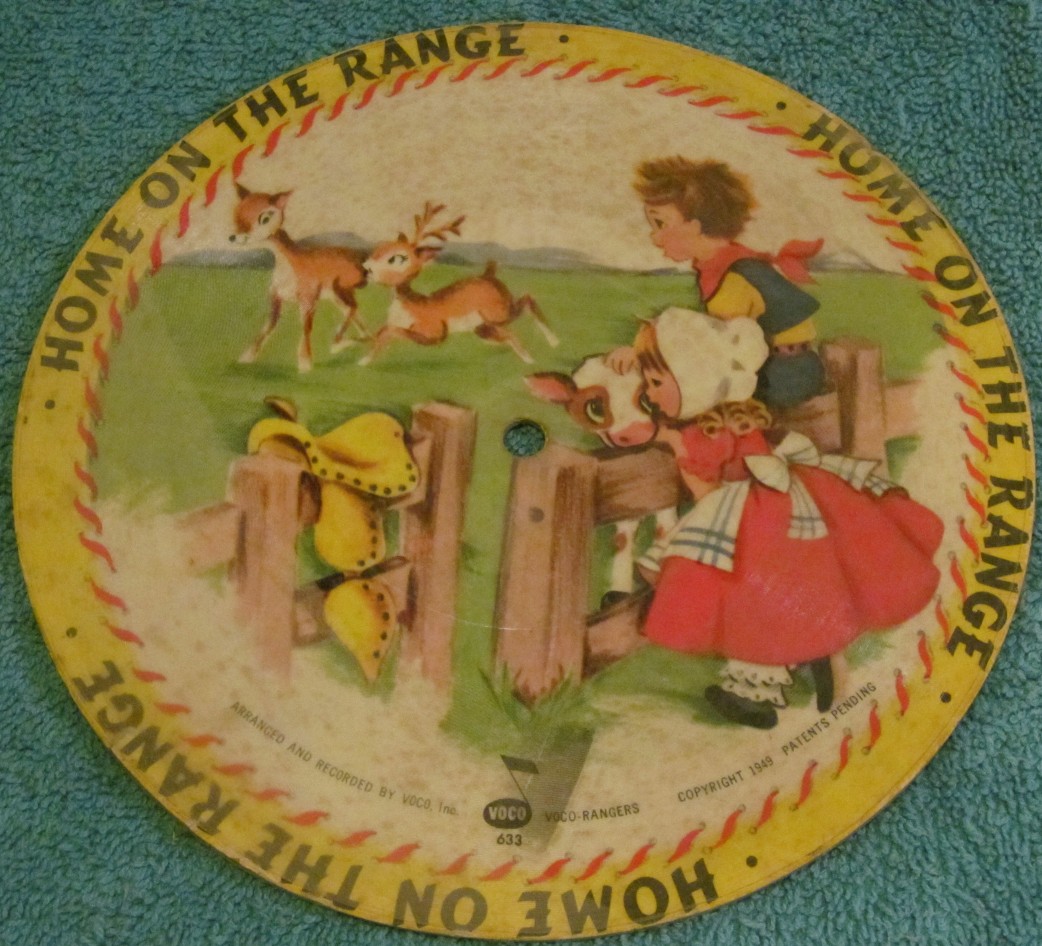
Flexi disc—These are very thin vinyl sheets that came often in magazines as promotions or to provide supplemental materials. I don’t have any in my collection so I’ll provide a Wikipedia link to provide more information and pictures.
https://en.wikipedia.org/wiki/Flexi_disc
Lastly, lower your stylus and enjoy!

Credits for images that are not mine:
Amos, Evan. “12in-LP-Vinyl-Record-Macro-Grooves.” Digital image. Wikimedia.
February 17, 2017 Published. Accessed February 22, 2017. https://commons.wikimedia.org/wiki/File:12in-LP-Vinyl-Record-Macro-Grooves.jpg.
Berliner, Emile. “The Improved Gramophone.” Transactions Of The American
Institute Of Electrical Engineers 8, no. 1 (January 1891): 19.
[Emile Berliner, with the model of the first phonograph machine which he
invented]. [Between 1910 and 1929] Image. Retrieved from the Library of Congress, https://www.loc.gov/item/99471767/. (Accessed February 20, 2017.)
Thomas Edison. [Between 1870 and 1880] Image. Retrieved from the Library of
Congress, https://www.loc.gov/item/brh2003000454/PP/. (Accessed February 20, 2017.)
